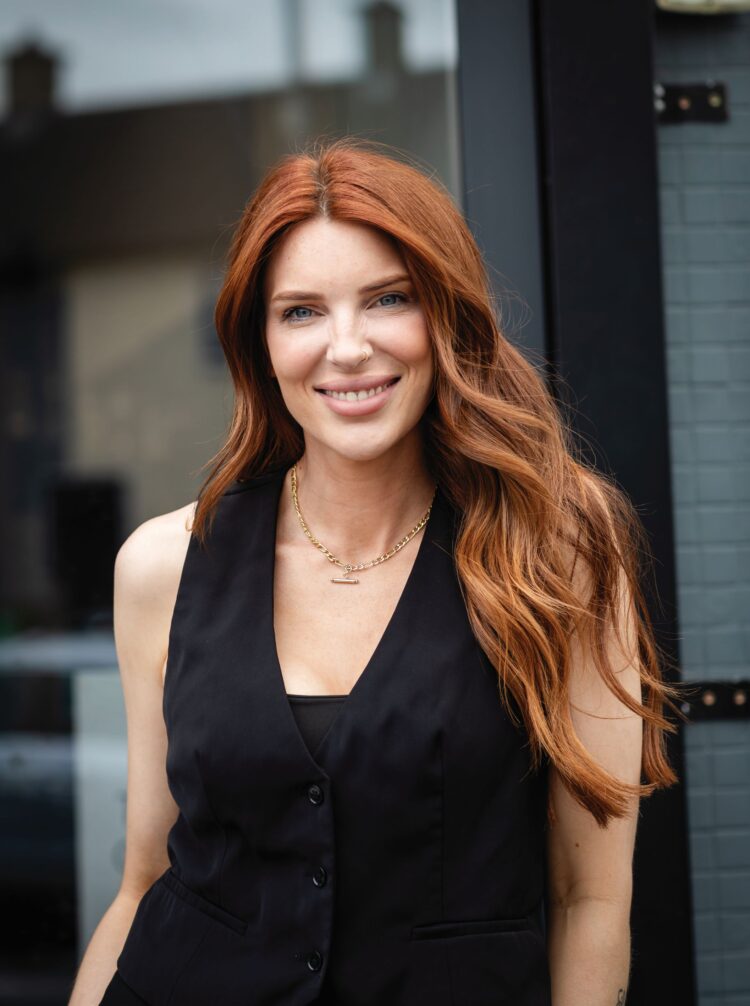Dublin native Stephanie Maher opens up to Niamh Devereux about overcoming addiction and how it inspired her business
When passing a hair salon on the Crumlin Road in Dublin, its name will no doubt catch your eye: The Sober Colourist. Peek your head in and you’ll spot a Fleetwood Mac print emblazoned with the words ‘Rock On, Gold Dust Woman’. It couldn’t sum up its owner, award-winning colourist Stephanie Maher, any better.
Having overcome a severe drug and alcohol addiction, she now runs this bespoke salon which she describes as a nurturing, inclusive, safe space, for clients and her staff, with a concentrated effort on improving the wellbeing of anyone that steps inside. It’s a modern Steel Magnolias, as she describes it, where conversation flows freely. “Hair therapy,” I suggest to her, and she hits back with “Hair-apy!”
Currently, she’s in the midst of expanding to a vastly bigger unit, with ambitious plans to establish a hairdressing course for women who are in early addiction recovery or leaving prison. This is something that would have greatly benefitted her when she was navigating her own addiction journey and struggling to find work – rediscover herself – after coming out of treatment, she tells me.
Stephanie speaks about her past with wisdom and self-compassion, a result of the work she’s put in to understand and have empathy for herself in recent years. “I’m not ashamed of my background,” she says. “I wouldn’t be who I am today having not had that life.” She wanted to put her story as the name of the salon, because as she says, “vulnerability is a superpower”.
“I’m instantly putting my truth out there, and it disarms people. The area (Crumlin) has had really hard times in terms of drug addiction and an awful lot of people that come in have had someone close to them affected by it.”
As a teenager, Stephanie discovered alcohol, and at 16, she tried cocaine for the first time. “My brain just went, “Oh my god, this is brilliant!”,” she says. “This year, I was diagnosed with ADHD which I’m now medicated for, and I now understand that my brain actually required a certain level of stimulus. Cocaine is so, so addictive, and I would have an addictive personality. So, it took over very, very quickly.
“By the age of 21, I was living in a treatment centre. I’d had my first child and I was in an awful state. But, I still had no interest in giving up drugs. I’d pretend to my mam and dad that I was invested in quitting, but I wasn’t. I wasn’t ready,” she says. “The thing is, no matter how dire the situation is, it won’t matter until there’s a switch or a moment where you concede to your inner most self that you’re done with this life. Some people unfortunately never get to have that.”
Finding the switch
Stephanie says her addiction was bringing her on a downward spiral in a way she could never have envisioned for herself. “I had a mental defect, in the way that I was thinking. At one point, I was drinking glasses of wine bringing my kids to school,” she says. “I was doing drugs I said I’d never do; it got to the point where I was smoking crack. I was about to lose my children, and my family were at their wits end with me.”
The switch she previously mentioned came to her one Christmas night, after she fell down the stairs and knocked herself unconscious. “I was there with my youngest and he thought I was dead,” she says, “He had the savvy to ring my folks and get them to come down and help. My dad looked at me the next day; I had no recollection of anything, and he said, ‘We’re done with you’. I knew if I didn’t get help, I would die. And I couldn’t do this anymore to my kids and family. So, I entered into a 12-step programme.”

She continues: “I met an amazing woman who became my sponsor and she helped me shift all the guilt and shame, which would keep me up at night; I’d be waking up at 5am with anxiety over all my bad choices, feeling like a failed person. But being in the programme and following those steps began to change my life. I learned about why I had done what I done. I was able to look at my life like a tapestry, and see where the ball had started rolling.”
“I had to face very ugly parts of myself. But I couldn’t heal unless I did,” Stephanie says. “And I really knew I’d go back to drugs and die if I didn’t heal. It felt like I had a spiritual plunger on me, getting out all the sludge that had built up in me. Addiction is a spiritual sickness, as well as physical and mental. I believe the spiritual side comes from trauma blowing a hole up inside of you, and you want to fill it, whether that’s with food, shopping, men, women, alcohol, or drugs. Learning more about addiction – and of my ADHD – I never had a chance. I put down the whip a bit and showed myself more empathy.”
Embracing sobriety
In December, she’ll be six years sober. “If I can get through it, anyone can,” Stephanie says. “Addiction is insidious and it doesn’t discriminate. My advice is that if you feel something has become problematic for you, there are programmes, sober support groups, SMART Recovery meetings, counsellors, family after-care…just take the first step and reach out, even if it’s opening up to someone you trust.”
At the entrance of her salon is an olive tree, a sign of friendship, healing and above all, peace. Does Stephanie feel peace now, I ask?
“I never had peace or equilibrium in my life, and I wanted this plant to set that intention and create that kind of environment for everyone coming in. Of course, life is life; things can crop up that rock the solid foundation I’ve built, but I always go back to the tools I was taught when that woman, my sponsor, took me under her wing. My focus is: ‘What have I packed into the stream of life; what have I brought to today, to make things better?’ And that changing of mindset does bring me peace.”
Visit thesobercolourist.ie for details on Stephanie and her services. You can read more about this topic in our Invisible Struggle series in the Sept|Oct issue of Irish Country Magazine, in shops now.







